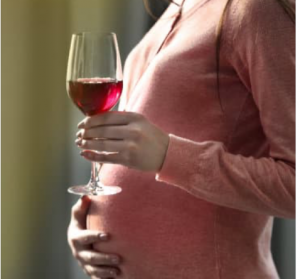Health with Humanity

By Joanna Burke-Bajaj

Fetal alcohol spectrum disorders (FASD) include a wide range of possible negative effects on birth and fetus development from the consumption of alcohol during pregnancy. The first draft of the WHO Global Alcohol Action Plan 2022-2030 released in June 2021 has outlined many key areas of education and policy actions for WHO Member States to reduce the prevalence of FASD within their populations, but the most controversial of these is the recommendation that nations should take action for the “prevention of drinking among pregnant women and women of childbearing age” (WHO 2021).
To be clear, the risks associated with FASD are quite high, with no conclusive threshold of exactly how much alcohol exposure can be tolerated during pregnancy with zero risk to fetal development (Lange et al. 2017). Along with evidence from studies in mice showing teratogenic effects from any amount of alcohol consumption through any phase of pregnancy, the evidence of the potential harms from FASD are serious enough to support the medical advice stating that pregnant women should not consume any alcohol, but the issue is that this advice should NOT extend to limiting the freedoms of women who simply happen to be of childbearing age. Not all women of childbearing age: are sexually active, can become pregnant, are at risk of being pregnant, have sex with men in a way that could result in pregnancy, or drink enough for there to be a risk of having consumed alcohol while not aware that they are pregnant.
To recommend restrictions on the choices of all women of a certain age, based on the idea that every one of them could possibly become pregnant at an unplanned time while having inadvertently consumed alcohol is incredibly short-sighted public health practice, and even worse, is a deeply misogynistic solution that is rooted in a paternalistic attitude that many women have come to expect and mistrust in the medical industry. Treating all young women as if they primarily exist for the purpose of reproduction is sexist and an incredibly poor practice in public health when the goal of public health messaging should be to reduce health harms while building trust and education.
All too often in medicine, the health needs of women as individuals are viewed as being of less importance than the health needs of women who are pregnant or could be pregnant, and sometimes even women who are no longer of childbearing age find their health concerns not taken as seriously as when they were beginning motherhood. In some regions of Canada, the waiting list for an appointment with a gynecologist can be many months or even a year when presenting without any potential risk of pregnancy, but for pregnant women this process is expedited and an OB-GYN appointment can be scheduled very quickly. The CDC has used an opt-out approach to prenatal HIV testing since 1998 to ensure that all pregnant women are screened for HIV, but for non-pregnant women such testing can be an expensive addition that is not always part of standard sexual health testing recommended by a physician. One study in Ontario found that almost 3% of women who were identified as diabetic during pregnancy testing actually did not have gestational diabetes but rather had Type 2 diabetes that had been previously undiagnosed by their physician (Lee et al. 2020). There are many excellent reasons why women who are pregnant may receive more and faster access to care, particularly due to the many health risks associated with pregnancy. However, the issue is not simply that pregnant women have more accessible care. The problem is that women who are not pregnant should also be able to expect timely and appropriate care and screening for health concerns. When women navigate a health system that provides a significant difference in the accessibility and quality of care during the time that they are pregnant, and simultaneously recommends that their freedoms be restricted during any years in which there is a hypothetical possibility of them becoming pregnant, it begins to feel as though in the eyes of the medical industry the humanity of women is essentially reduced to the function of reproduction.
Women’s medical choices are often constrained to those which leave the best capability for future or current reproduction status, regardless of the health wants and needs of the woman for herself independent of reproduction. In the same way, with these new recommendations the WHO is effectively telling young women that they should not have the right to make choices about their own alcohol consumption, and rather should have this freedom taken away from them in the interest of a hypothetical fetus. In response to these new guidelines, Dr. Jen Gunter wrote a satirical article pointing to the misogynistic undertones of the recommendations by adding that there are risks to pregnancies from male partners consuming alcohol as well, including risks of intimate partner violence (IPV), and asking “what if all men of impregnating age should be prevented from drinking alcohol to improve pregnancy outcomes” (Gunter 2021)? It is easy to see how this idea would of course sound ridiculous and seem like a very broad overreaction to limit the freedoms of all men who could ever possibly contribute to pregnancy, but this is essentially the same type of sweeping recommendation imposed on women by the WHO’s action plan draft.
Like what you read?
More on Joanna Burke-Bajaj here.
References
Gunter J. (2021). A Modest Proposal: All men of impregnating age should be prevented from drinking alcohol to improve pregnancy outcomes. The Vajenda. Blog. Accessed at https://vajenda.substack.com/p/a-modest-proposal-all-men-of-impregnating
Lange et al. (2017). Global Prevalence of Fetal Alcohol Spectrum Disorder Among Children and Youth: A Systematic Review and Meta-analysis. JAMA pediatrics, 171(10), 948–956. https://doi.org/10.1001/jamapediatrics.2017.1919
Lee D, Booth GL, Ray JG, Ling V, Feig DS. (2020). Undiagnosed type 2 diabetes during pregnancy is associated with increased perinatal mortality: a large population-based cohort study in Ontario, Canada. Diabet. Med. 37, 1696– 1704.
Schölin L. (2016). Prevention of harm caused by alcohol exposure in pregnancy. Rapid review and case studies from Member States. World Health Organization Regional Office for Europe, Geneva. ISBN 978 92 890 5164 4. Accessed at https://www.euro.who.int/__data/assets/pdf_file/0005/318074/Prevention-harm-caused-alcohol-exposure-pregnancy.pdf
WHO. (2021). Global alcohol action plan 2022-2030 to strengthen implementation of the Global Strategy to Reduce the Harmful Use of Alcohol. World Health Organization, Geneva. Accessed at https://cdn.who.int/media/docs/default-source/alcohol/action-plan-on-alcohol_first-draft-final_formatted.pdf?sfvrsn=b690edb0_1&download=true

